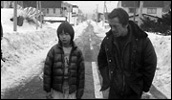Little Wing
- Year
- 2005
- Original title
- Yumeno
- Japanese title
- YUMENO
- Director
- Cast
- Running time
- 93 minutes
- Published
- 25 August 2005



by Jasper Sharp
Little Wing's elegy to Japan's lost generation, for whom parental influence is at best ineffectual, at worst downright destructive, is heavily redolent of a strain of cinema that was prevalent during the years running up to the end of the millennium. It's a strain which could accurately be said to have begun with Shinji Aoyama's feature debut Helpless in 1996 and drew to its natural conclusion with the same director's Eureka in 2000.
Its central male character, Yoshiki (Kobayashi), like Tadanobu Asano in Helpless, seems ungoverned by the codes of either conventional human behaviour or internalised morality, and is prone to fits of explosive rage whose consequences place him outside of society and on the wrong side of law. In the opening scene, we watch him, a nervous youth, his hair bleached fashionably blonde, driving across the long suspension bridge leading into Tomakomai, an industrialised port town located on the southern coast of the icy landmass of Hokkaido. After he is almost run off the road by an overtaking car, the two drivers step out onto the roadside and square up to one another. Before Yoshiki has driven off again, he has battered the other man to death with a lead pipe. This is not, as we shall see, the first time a brutal act of violence has caused Yoshiki to flee, nor will it be the last.
Yoshiki is but one of the three young characters who find their fates inextricably linked by the end of the film, outsiders with no connection to their roots, their environment or their fellow human beings, who find themselves thrust uneasily together by circumstance and drifting aimlessly around Hokkaido's wide, expansive landscape, far removed from the societies in which their personalities were forged. Yoshiki's flight initially leads him to the home of high school girl Yumeno (Nahana). Like many teenagers, her relationship with her parents borders on antagonism, as she asserts her individuality by wearing bright blue contact lenses and has embarked on her own explorations into the world of adulthood through an affair with a married man. She is nevertheless understandably shocked to return home one day to find both parents lying slain in a pool of their own blood with a peroxide-headed delinquent standing above their corpses clutching a knife.
During the first half hour, Little Wing seems to be trotting down a fairly well-worn and conventional path, though, it has to be said, it does so with considerable verve and invention, with the story cutting between the individual characters and sketching out their milieus. But then, just as we think we are beginning to get a handle on which direction the film is heading, the script unexpectedly jumps back three days beforehand to reveal that this is not the first time that Yoshiki and Yumeno have met. Scenes that initially only seemed loosely connected with the main narrative suddenly attain a new significance as the film begins to adopt a new form.
Which is where the third character of Ryo (Kanai) fits in. An eleven-year-old boy living in the snowy wilderness of Hokkaido's interior alone with his alcoholic father after his mother deserted the family, Ryo's role within the plot is not immediately clear from the early scenes in which he appears, but after his father steps out into the frozen outdoors one evening, later to be found by the police, his corpse frozen stiff, events soon bring him into the immediate sphere of the other two characters.
That parallels can be so easily drawn between the themes and subject matter of Little Wing and the work of Shinji Aoyama comes as no real surprise when you look at the track record of its scriptwriter Kishu Izuchi, a man who got his break in the industry alongside Aoyama writing the script for the pink film Dream of Garuda (1994) along with that film's director, Takahisa Zeze, under the collective pseudonym of Saburo Rakan (or Lacan). Izuchi later rejoined forces with Aoyama for the experimental film To the Alley as the human figure at the centre of this exploration between landscape and culture, reading out passages from the works of Kenji Nakagami, the poet/novelist from Japan's "unclean" burakumin caste, in locations similar to the ones which inspired them.
While Aoyama quickly stepped out of the pink filmmaking community, Izuchi honed his screenwriting skills within this environment with a series of scripts for Zeze that went leagues beyond the basic requirements of the sex film. His collaborations with the director in the late-90s, resulted in some bona fide mini-masterpieces of Japanese independent cinema, with works such as Raigyo and Dirty Maria. The elliptical, fragmented style of both of these works, with their basis in real-life crimes committed in the early stages whose full details and repercussions are revealed gradually over successive scenes, as well as the snowbound settings of Dirty Maria, is much in evidence in Little Wing. Izuchi also penned 21st Century Girl, the second feature of Zeze's assistant director Rei Sakamoto, as well as several of Zeze's works outside of pink, including Kokkuri, Rush!, and Hysteric. Along with the director, Izuchi also helped tidy up the screenplay for Moon Child, whose story originated with one of the film's stars, the teen idol Gackt.
Similarly, Little Wing's score was composed by Isao Yamada, whose work in pink is balanced by his musical contributions to all of Aoyama's work of the previous decade. Yuna, the perky heroine from Aoyama's Wild Life pops up in a minor role, as does a familiar face from the pink world, Takeshi Ito, playing Ryo's father.
All of this points to the significant role that the pink film plays in Japanese independent film production, or to be more precise, the role played by the company Kokuei. Though produced by Moving Pictures Japan, Kokuei played a major part in getting this ambitious project off the ground through the perseverance of veteran producer Daisuke Asakura. Central to the production is director Kamada, one of the so-called Seven Lucky Gods (shichifukujin) of the pink world, who took over the mantle from the directors who served as their mentors, the Four Devils, in the late 1990s. After directing two pink films in 1998, Waka-zuma: Furin no Kaori (Young Wife: The Fragrance of Adultery) and No Woman No Cry (Abunai Joji: Kedamono no Shitatari), Little Wing marks Kamada's first break into non-erotic filmmaking, and it's a very impressive debut indeed.
Realised with a far more generous budget than that granted to the average pink production, the impressive widescreen cinematography of Atsuhiro Nabeshima (Scoutman, Tokyo Noir) recalls Masaki Tamura's work on Eureka, full of long wide-angle shots of the figures struggling against the natural elements, moving pinpricks in the snow, images which cry out to be seen on as large a screen as possible.
Yumeno is a remarkably assured film that met with an enthusiastic response on its first overseas screening at Frankfurt's Nippon Connection festival, and it is going to be interesting to see what path Kamada's subsequent career will take from here. Taking the best elements from the aforementioned works of Aoyama and Zeze in the 90s, but within a more compelling and dramatically structured narrative, and with powerful performances from all concerned (especially the young Kanai), Kamada's starkly beautiful debut proves that the Japanese indie scene is still capable of turning out challenging and technically accomplished works that touch upon subject matter beyond the scope and ability of the Japanese mainstream.